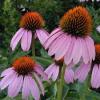
Fall may be seen as the “end of the season,” but it’s still a great time to think about planting a garden to benefit our pollinator friends.
Pollinators include butterflies, hummingbirds, native bees, and honey bees, which are not native to North America, but still benefit our ecosystem. They all need to eat pollen and nectar, and drink water to survive.

Here is a short list of perennial flowers that can be planted in the fall and will come up nicely in the spring. One of my favorites is the purple coneflower, Echinacea. Another favorite is bee balm, Monarda didyma! More perennial flowers include salvia, asters, perennial sunflowers, and yellow coneflowers (Ratibida pinnata). All of these are native flowers to North America.

When planting your pollinator garden be sure to have well drained soil, follow the planting dimensions for space between plants, and mulch lightly giving the roots an extra layer of protection from freezing. Weeds are inevitable as weed seeds are in all soils, so pull them as them come up. Feed with a small amount of organic fertilizer or with a small amount of nitrogen more phosphorous and potassium; use a 4 – 10- 10 formula. Fertilizer sticks provide a slow release of nutrients.

If you feel energetic and get the cooperation from the local roadway managers in your municipal district, you can also plant “seed balls,” a mixture of flower seeds and light clay that can easily be deployed by throwing them into the median strips of local roads.
Be sure to coordinate this with the roadway managers so that your newly planted pollination flowers are not mowed down during the summer mowing season. Your city or county may have ways to volunteer to either plant or care for pollinators already planted. The best part of creating a pollinator garden is that the sky is the limit; go as big or as small as you like. Moreover, the nice thing about fall is that prices for perennial flowers are drastically reduced; therefore get out there plant a perennial pollinator garden now!
Flowers from left to right; purple coneflower, Echinacea; bee balm, Monarda didyma; salvia, Salvia; asters, Aster; perennial sunflower, Helianthus; and yellow coneflower, Ratibida pinnata. There are any number of great books you can reference to plant for pollinators, such as Pollinator Friendly Gardening, by Rhonda Fleming Hayes.
Written by Bob Borkowski, a 2016 graduate of the Institute of Applied Agriculture at the University of Maryland in sustainable agriculture and an avid beekeeper. He enjoys doing presentations involveing honey bees, native bees and pollination.
